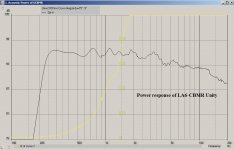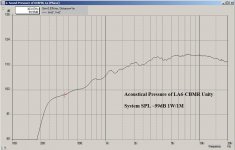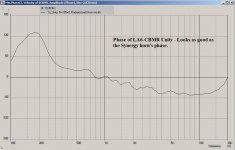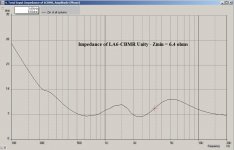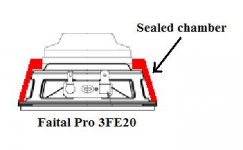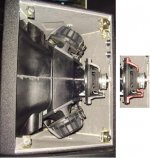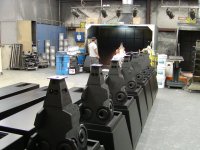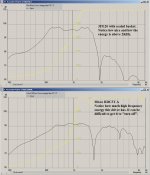I've had a TF0615MR in my hands and I can tell you it is a piece of junk. If I wanted to use a 6", then I'd just go to the Eminence LA6-CBMR. I already have an Akabak script written for the LA6-CBMR that is near perfect. I just want something smaller so it makes it easier to fit woofer on the horn for a 3-way Synergy. I really want the mids rolling off between 450Hz and 600Hz.
Attachments
Hello John,
This thread, the search for some suiteble midrange drivers for a unity horn
keep inspiring me. I would like to build some high power unity`s.
I also think the celestion driver is the best choice, but they aren`t available easy. They can be bought as a pack of 244 pieces. Maybe if the interest is big enough we can arrange a group buy. I know some suppliers.
Drivers bigger than 5" would be a lot easier, because there are plenty enough, but the problem you won`t get high enough, because you don`t get the midranges close enough to the CD.
Another option would be the newer drivers from Faital. They are going to have a new type 4FE30. They look very suiteble, strong motor, if you can make a very tight sealed back for it.
If we all want to have some midrange drivers, probably we have to arrange some sort off group buy. Only then it is also possible to let a company make a special 4 or 5" driver.
John,
What your script looks like for the unity? The eminence driver indeed looks good. Are you aiming for flat freq response with the acoustic power plot or flat response with the pressure plot?
Cheers,
Marcel
This thread, the search for some suiteble midrange drivers for a unity horn
keep inspiring me. I would like to build some high power unity`s.
I also think the celestion driver is the best choice, but they aren`t available easy. They can be bought as a pack of 244 pieces. Maybe if the interest is big enough we can arrange a group buy. I know some suppliers.
Drivers bigger than 5" would be a lot easier, because there are plenty enough, but the problem you won`t get high enough, because you don`t get the midranges close enough to the CD.
Another option would be the newer drivers from Faital. They are going to have a new type 4FE30. They look very suiteble, strong motor, if you can make a very tight sealed back for it.
If we all want to have some midrange drivers, probably we have to arrange some sort off group buy. Only then it is also possible to let a company make a special 4 or 5" driver.
John,
What your script looks like for the unity? The eminence driver indeed looks good. Are you aiming for flat freq response with the acoustic power plot or flat response with the pressure plot?
Cheers,
Marcel
I aim for a fairly flat power response that rolls off above 10KHz. Completely flat power response is way too bright sounding to me. The acoustic pressure needs to raise due to the falling power response of the conical horn. However, it is this falling response that allows the conical to be CD.
I've modeled with the Faital 3FE20 and it works well if you can get a back chamber of 0.037 Liters. That's really small, and I don't know if it is possible. Of all the FE series, the 3FE20 is the only suitable one because it has a treated cloth surround. All the other sizes have a rubber surround. I'm not all that happy about the single roll cloth surround of the 3FE20, but I guess I'll just have to live with it.
I plan to purchase one 3FE20 and see if I can make a small enough back chamber for it. If it works, then great! If not, then I'll just be out $30.
I've been modeling in Akabak with the Misco RDC3T-A and got a complete 3-way Synergy finished. The only issue is the cost to try them. They have to be bought in lots of 30 pieces at about $8.40 each. So, it will run over $250 to try them, and they are non-returnable.
I've modeled with the Faital 3FE20 and it works well if you can get a back chamber of 0.037 Liters. That's really small, and I don't know if it is possible. Of all the FE series, the 3FE20 is the only suitable one because it has a treated cloth surround. All the other sizes have a rubber surround. I'm not all that happy about the single roll cloth surround of the 3FE20, but I guess I'll just have to live with it.
I plan to purchase one 3FE20 and see if I can make a small enough back chamber for it. If it works, then great! If not, then I'll just be out $30.
I've been modeling in Akabak with the Misco RDC3T-A and got a complete 3-way Synergy finished. The only issue is the cost to try them. They have to be bought in lots of 30 pieces at about $8.40 each. So, it will run over $250 to try them, and they are non-returnable.
Attachments
For the 3FE20, 37CL would be very small. It will be very difficult to work out
that sealed back. 37CL would be a free air resonance of around 591Hz.
The are wonderfull drivers, also it`s bigger brother the 4".
At misco you can also make your own drivers. Maybe it`s not that expensive at all.
Thought about this driver?
PYRAMID M57 5.25'' 120 Watt Poly Midrange Speaker
that sealed back. 37CL would be a free air resonance of around 591Hz.
The are wonderfull drivers, also it`s bigger brother the 4".
At misco you can also make your own drivers. Maybe it`s not that expensive at all.
Thought about this driver?
PYRAMID M57 5.25'' 120 Watt Poly Midrange Speaker
I aim for a fairly flat power response that rolls off above 10KHz. Completely flat power response is way too bright sounding to me. The acoustic pressure needs to raise due to the falling power response of the conical horn. However, it is this falling response that allows the conical to be CD.
I've modeled with the Faital 3FE20 and it works well if you can get a back chamber of 0.037 Liters. That's really small, and I don't know if it is possible. Of all the FE series, the 3FE20 is the only suitable one because it has a treated cloth surround. All the other sizes have a rubber surround. I'm not all that happy about the single roll cloth surround of the 3FE20, but I guess I'll just have to live with it.
I plan to purchase one 3FE20 and see if I can make a small enough back chamber for it. If it works, then great! If not, then I'll just be out $30.
I've been modeling in Akabak with the Misco RDC3T-A and got a complete 3-way Synergy finished. The only issue is the cost to try them. They have to be bought in lots of 30 pieces at about $8.40 each. So, it will run over $250 to try them, and they are non-returnable.
Deja Vu - I just did that last night. I didn't even see your post until today. Weird.
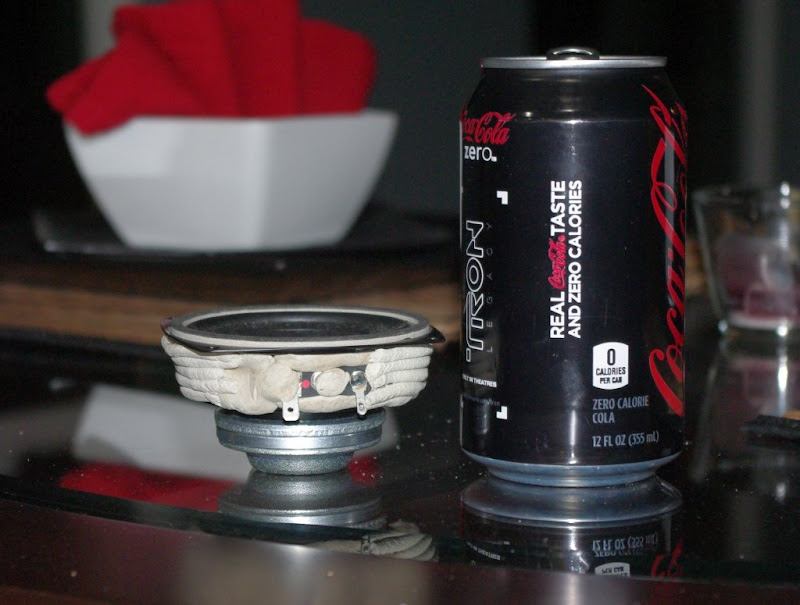
Here's a pic. I didn't seal off the basket permanently, I just used rope caulk to make it airtight. I have a whole box full of ruined Tang Band woofers, so I wanted a non-permanent solution
With the basket sealed off, I measured a Fb of 590hz, and a qts of 2.3. This is consistent with what was predicted. I had to calculate qms and qes by hand, because my Woofer Tester was freaking out over wiggles in the impedance curve.
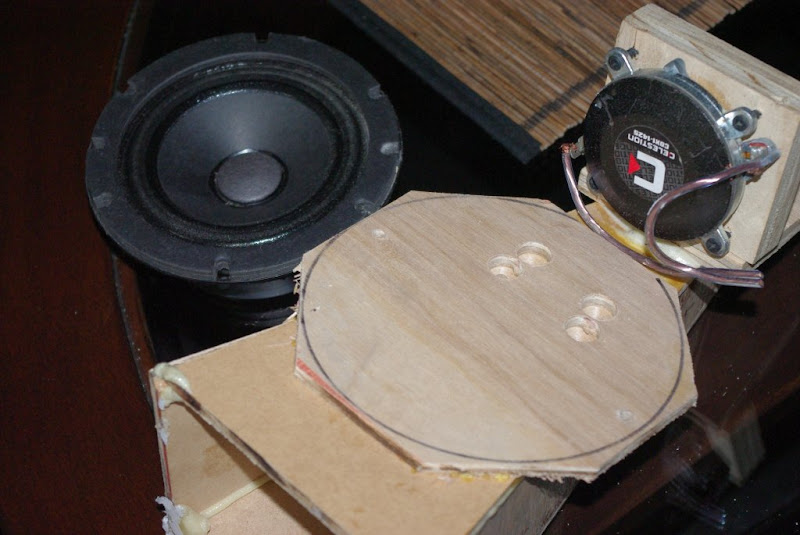
If anyone's curious what I'm up to, check out my forum. (forum.audiopsychosis.com) This is a very VERY narrow angle unity horn. I'm doing some ambiophonic experiments, to see if we can substitute a narrow angle waveguide for the physical barrier used in ambiophonics.
Here's a question for the horn gurus:
In the past I've noticed that the Misco JC5RTF-B doesn't sound very good. I've blamed this on it's high distortion. But last night I noticed in the spec sheet that it has a very high QTS of 1.8. What would be the downside of using a larger chamber? Would enlarging the chamber size reduce the "boominess" that I am hearing? A larger chamber would lower efficiency, but would lower QTS too. Or is there another way to mask the boominess of this very small enclosure?
This is particularly important with the Faital woofer, because the Faital has a qts of 2.3 with a sealed back, versus 1.8 for the Misco.
Did you measure distortion? How high, at what frequencies, of what order is it? What does the frequency response look like? You don't really give enough information, but if you're saying it doesn't sound good on the really small horn you show, my wag is that the response is wrong and / or it has massive diffraction / reflections due to the really small mouth with no termination.
I don't know if the asymmetry of the driver/entry has any impact on the sound, but I've wondered about it. The internal distances for a 5" driver are getting to the 1/4 wavelength for its upper range in the Unity.
With a 3" driver, we could place the drivers on the corners of the horn, via a flat mounting plate (instead of on the flat of the rectangular horn). A single hole (or slot) could be centered on the driver and still be closer to the apex. And the entry, being right in the corner of the horn, would be less "visible" to the tweeter.
John (s?), how would you best terminate the entry?
Sheldon
With a 3" driver, we could place the drivers on the corners of the horn, via a flat mounting plate (instead of on the flat of the rectangular horn). A single hole (or slot) could be centered on the driver and still be closer to the apex. And the entry, being right in the corner of the horn, would be less "visible" to the tweeter.
John (s?), how would you best terminate the entry?
Sheldon
I would not get too excited about the Qts of a mid that has a sealed basket. If you really want to compare the JC5RTF-B to the 3FE20, then cut open the basket on the JC5RTF-B and measure it's Qts. While it's Qts will not be as low as the KCN5FD, it will probably be reasonable for a pro sound 5" mid. Additionally, I don't think Qts or Qes is the main driving force behind the sound quality. Sheldon might be onto something. The 1/2WL reflection inside the sealed basket might be very close to the high frequency crossover point. If this is the case, then a smaller mid will allow us to avoid this problem.
John, thus far does the sealed up 3FE20 sound better to you than the JC5RTF-B?
John, thus far does the sealed up 3FE20 sound better to you than the JC5RTF-B?
Sheldon,
I did something similar to what you're talking about with the corners using 5" drivers. If you make the flat walls extend past each other on one side of each wall, you can shift the drivers off the center of the panels and fit larger drivers closer to the throat. I did this on my horn I built 10 years ago. There are some recent pics of it further up the thread although it's kind of hard to see this detail. I do have single entry points for the mids that are in the corners of the interior of the horn.
The best way to do the holes is to make very small diameter, very short holes with rounded ends to reduce turbulence (like a port for a vented box). Small short holes have high impedance which is what prevents the tweeter from 'seeing' the holes. When I did this on the horn I'm using in my garage, I got great response out of the tweeter (that is, smooth). However to get high sensitivity with relatively flat response from the mids with holes like this, you need certain T/S parameters that my drivers did not have. So my mid response was crap. I then enlarged my holes (a lot) to confirm the prediction of my matlab design script. It worked, and now that horn has great midrange response but horrible tweeter response. It still sounds okay, but the tweeter response is not smooth.
I did something similar to what you're talking about with the corners using 5" drivers. If you make the flat walls extend past each other on one side of each wall, you can shift the drivers off the center of the panels and fit larger drivers closer to the throat. I did this on my horn I built 10 years ago. There are some recent pics of it further up the thread although it's kind of hard to see this detail. I do have single entry points for the mids that are in the corners of the interior of the horn.
The best way to do the holes is to make very small diameter, very short holes with rounded ends to reduce turbulence (like a port for a vented box). Small short holes have high impedance which is what prevents the tweeter from 'seeing' the holes. When I did this on the horn I'm using in my garage, I got great response out of the tweeter (that is, smooth). However to get high sensitivity with relatively flat response from the mids with holes like this, you need certain T/S parameters that my drivers did not have. So my mid response was crap. I then enlarged my holes (a lot) to confirm the prediction of my matlab design script. It worked, and now that horn has great midrange response but horrible tweeter response. It still sounds okay, but the tweeter response is not smooth.
Like in one of my posts above, I want to seal the rear of the 3FE20 just like Danley sealed the rear of the BMS 5CN140 used in the SM-60F. See that attached picture. I copied the section of interest and outlined the cutaway chamber in red. It looks like getting to around 600Hz with the 3FE20 will be possible.
Attachments
Sheldon,
I did something similar to what you're talking about with the corners using 5" drivers. If you make the flat walls extend past each other on one side of each wall, you can shift the drivers off the center of the panels and fit larger drivers closer to the throat. I did this on my horn I built 10 years ago. There are some recent pics of it further up the thread although it's kind of hard to see this detail. I do have single entry points for the mids that are in the corners of the interior of the horn.
This is what Mr. Sheerin is talking about. It is the same thing I intended to do if we got stuck using 5" mids. Basically, each panel of the horn lap over the next side.
Attachments
I'm comparing the raw midrange response of the sealed 3FE20 and the RDC3T-A. Perviously I had mentioned that it can be difficult to get the RDC3T-A to turn off in the high frequencies. That complicates the crossover some. It also makes matching phase with the compression driver more challenging. Either way, I got it to work just fine in Akabak. The 3FE20 has better sensitivty, but that point is moot because the compression driver is the limiting factor. Where ever you get the comp driver to EQ out to sets the system sensitivty. That's one reason why the BMS comp drivers are so good for a Unity. They have better high frequency energy than just about anything else on the market.
Attachments
This is what Mr. Sheerin is talking about. It is the same thing I intended to do if we got stuck using 5" mids. Basically, each panel of the horn lap over the next side.
I was trying to describe mounting the mid orthogonal to it's present position. Think of the corner of the horn as a peaked roof. Slice off a bit off the peak and place a platform on it. Mount the mid on the platform. Sort of a two dimensional version of the way the tweeter is mounted to the horn apex. You could make the entry hole within a cm or so of the apex, if so desired.
JLH, any way to keep the high end of the Faital and push the bottom a little lower?
I was curious about the sensitivity. How about two of the Faital on opposing corners, instead of four?
Sheldon
Did you measure distortion? How high, at what frequencies, of what order is it? What does the frequency response look like? You don't really give enough information, but if you're saying it doesn't sound good on the really small horn you show, my wag is that the response is wrong and / or it has massive diffraction / reflections due to the really small mouth with no termination.
Hey John*,
I measured the distortion on a number of drivers which I was considering for my projects. The Misco measured the poorest. I think this is due to a couple of things. First, distortion is tied to excursion, and all of the other woofers which I evaluated appeared to have more excursion. Even the lowly 2" TB woofer has more excursion. And second, all of the other candidates appear to use an underhung motor, which is known to reduce distortion.
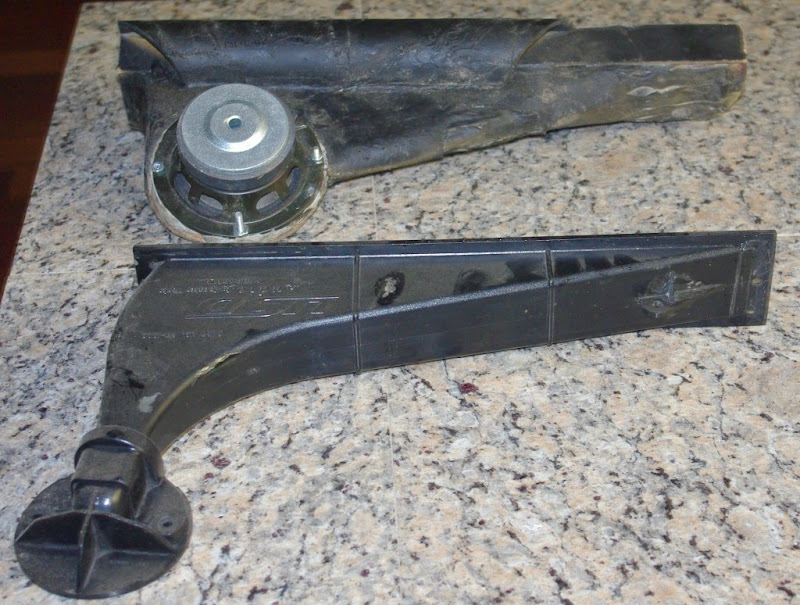
The horn at the top is the finished horn. Measurements below are with the sealed back mid, not the open back mid pictured.
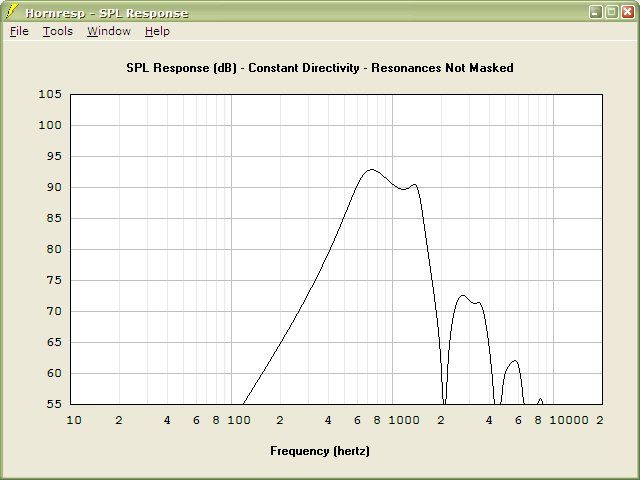
Here's the predicted response from hornresp
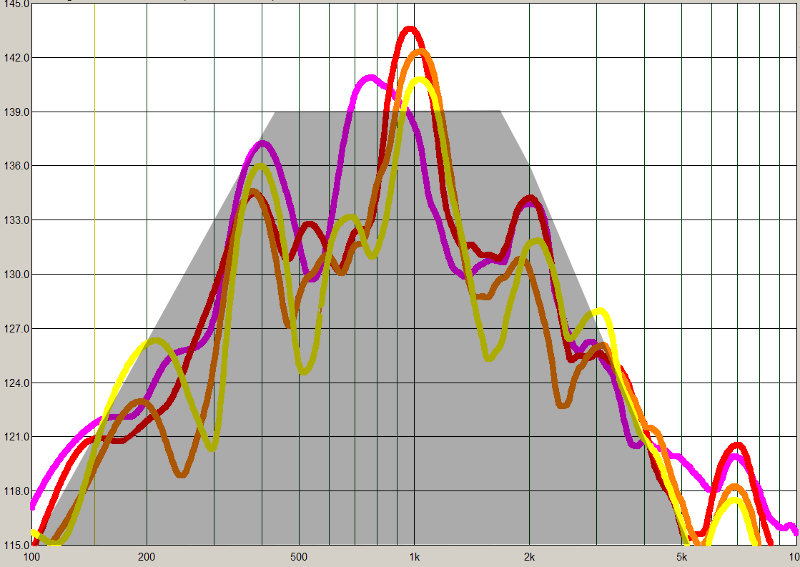
This is the measured response of the Misco woofer in my underdash horns. +/- NINE decibels is pretty awful
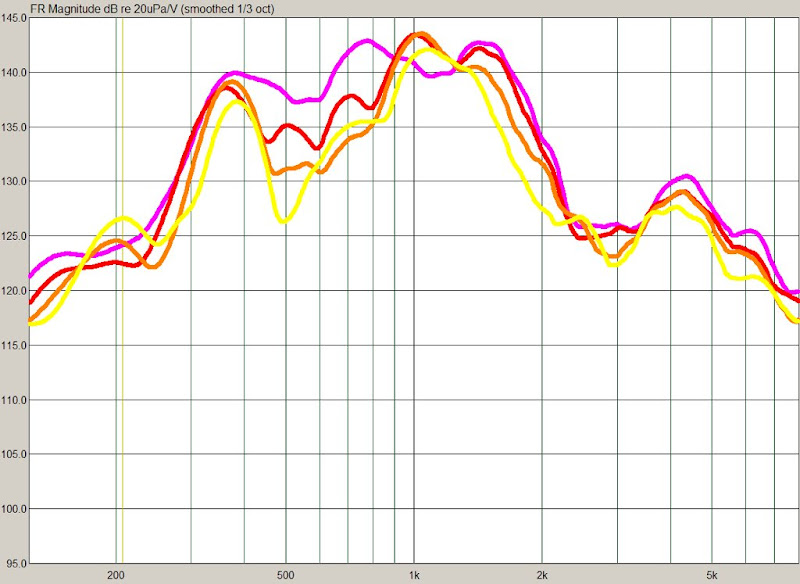
Here's the response after I added a bunch of braces. The horn was noticeably resonant, and I thought the buzzing was the problem. (I now think I was wrong.)
Anyways, a year ago I was convinced that the problem with my horn was the Misco driver, because the little Tang Band woofers worked quite well. But JLH's posts have me brushing up on my horn math, and I think the real problem was simply that the horn was way way too small.
IE, the horn that I used is too small for both woofers. But because the TangBand woofer is much smaller, the frequency response is much smoother. The Misco sounds raspy because it requires a much larger horn, not just because it's distortion performance is unspectacular.
* Why are all of us named John?
I was trying to describe mounting the mid orthogonal to it's present position. Think of the corner of the horn as a peaked roof. Slice off a bit off the peak and place a platform on it. Mount the mid on the platform. Sort of a two dimensional version of the way the tweeter is mounted to the horn apex. You could make the entry hole within a cm or so of the apex, if so desired.
JLH, any way to keep the high end of the Faital and push the bottom a little lower?
I was curious about the sensitivity. How about two of the Faital on opposing corners, instead of four?
Sheldon
Use a larger back chamber to lower Fs. 4 drivers vs. 2, you lose about 2dB. Considering 3dB is a doubling of power, losing 2dB is quite a bit to be giving up.
Use a larger back chamber to lower Fs. 4 drivers vs. 2, you lose about 2dB. Considering 3dB is a doubling of power, losing 2dB is quite a bit to be giving up.
Thanks, thought that would be the case, but I wasn't sure how important the back vs. front is. I haven't had any experience simulating it, but I have no problem fabricating what I need. Maybe playing with Winsd bandpass boxes would be instructive on the general trends, before I attempt the steeper learning curve of Akabak.
On 4 vs. 2; for some reason, I thought that the original Misco driver was in the mid 80 dB range. I went back and checked, and it's about 90 - so very similar to the Faital. I'd go with 4. This is looking more interesting. Seems quite feasible.
Sheldon
BTW, What do you make of the shape of the front chamber of the Danley horns shown in the picture you posted to illustrate the offset mounting. The circular channel is relieved for a rolled surround?
Oh, and (PB)John if you aren't going to use those Faitals, I'll take them off your hands.
Sheldon
Last edited:
In all of my Unity horns, I stuff the horn with poly fill or reticulated foam a la Geddes.
I was looking at the impedance plot of my Misco JC5RTF-B, and noticed that the impedanice peak was almost a full octave lower than what was predicted.
I can only hazard a guess as to what's going on here:
Again, I can only guess what's going on here. Further research is warranted, but it's something to consider since two of us are stuffing our horns.
I was looking at the impedance plot of my Misco JC5RTF-B, and noticed that the impedanice peak was almost a full octave lower than what was predicted.
I can only hazard a guess as to what's going on here:
- Is the added mass inside the horn changing the Fb of the woofer?
- Horn-loading has been known to push down the resonance of the woofer, but not to such a dramatic degree.
Again, I can only guess what's going on here. Further research is warranted, but it's something to consider since two of us are stuffing our horns.
I toasted my external sound card, so I haven't made any impedance measurements - though I guess I could use the laptop's internal card. I have taken quite a few FR measurements with the DEQX. I see very little difference with or without the foam, other than the modest roll off above about 7-10k.
Sheldon
Sheldon
The thing you need to know is when you load a 91dB mid into a Unity you pick up around 10dB. How much you actually pick up is determined by how strong a motor the mid has. This partly explains why the Faital 3FE20 has about 3dB more sensitivty in my models than the Misco JC5RTF-B. In addition, due to the increased loading, the Fs will drop too. A weaker motor will drop lower in frequency than a strong motor.
- Home
- Loudspeakers
- Multi-Way
- Suitable midrange cone, for bandpass mid in Unity horn.
